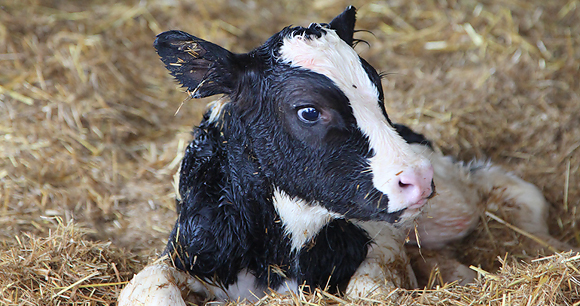Beef Cattle Vs. Dairy Cattle Resource
Cattle are raised to produce beef, veal, and dairy products. Learn more near dairy cows, calves raised for veal, cows raised for meat, and how they are raised.
Dairy Cows
The US Section of Agriculture counted approximately ix.4 million dairy cows used for milk production in 2020. Although all cows are grazing animals, inclined to live together in herds and range grasslands, most dairy cows today are kept in concentrated animal feeding operations (CAFOs—often referred to as "factory farms"), in open barns or tied in place to private stalls. Movement, socialization, and access to the outdoors is express or denied.
Today's dairy cow has been genetically selected to produce upwardly to 12 times the corporeality of milk needed to feed her calf. Producers have maximized productivity, simply the cows unquestionably endure poor welfare as a result. Producing such vast quantities of milk in one lactation bicycle is and so taxing and stressful that dairy cows are typically kept only for three or four years (or iii cycles of pregnancy, birth, and lactation) earlier they are slaughtered.
In traditional pastoral conditions, earlier industrial farming, cows could live up to 25 years, but today most cows suffer from lameness and other painful weather condition that are consequences of poor-welfare convenance practices in industrial systems.
High-welfare, pasture-based dairy farming represents a meaning improvement for cow welfare.
Veal Calves
In order for a dairy moo-cow to produce milk, she must give birth to a calf. While most female calves are kept with the herd to exist used for milk in one case they mature, male person calves typically are separated out to supply the veal or beef industry. Correct subsequently a dairy cow gives birth to her calf, farmers take the dogie away from the female parent. In the example of male person calves used for veal, until recently, nearly were confined in small, lonely stalls for 16 to 18 weeks until slaughter. In 2017, the veal industry completed its voluntary phase-out of the utilise of "veal crates," although information technology is possible that some producers continue to confine their animals in this style.

The approximately 456,000 calves killed for veal in the United States each year take no interaction with their mothers and take more limited concrete activeness than a typical calf raised for beefiness. Dissimilar calves raised for beef, nearly veal calves are housed indoors. Some veal calves are fed only a compromised liquid diet, and are purposefully kept anemic and weak in order to yield tender, pale meat. Considering veal calves are removed from their mothers and slaughtered at a very young age, some higher-welfare certification programs practise non certify any veal. From the perspective of those who consider animal welfare an of import consideration when farming, "high-welfare" veal is just not possible to produce.
Beef Cattle
Nearly 33 million cattle were raised for meat in the United States in 2020, according to the USDA.
Cattle raised for meat are usually on range for their showtime half-dozen to vii months of life. This initial ability to walk around, socialize, and eat the food virtually readily digestible for cows means that these animals first off with ameliorate lives than many other subcontract animals, such as pigs, chickens, and dairy cows.

However, conventional beef cattle systems also incorporate painful mutilations like castration, dehorning and disbudding, and branding, all without any medical relief for the pain. Even tail docking, typically associated primarily with dairy farms, may be performed when cattle raised for meat spend their early months not on the range simply in cramped indoor barns.
Whether cattle raised for meat start their lives on the range or inside a barn, however, they end upwardly on a feedlot for their terminal 6 months before being sent to slaughter. At the feedlot, cattle are confined together in dirty weather, standing on unnatural slatted concrete floors or in dingy "dry lots" free of vegetation. They are fattened on grain, which causes internal stress and disease because cattle stomachs have evolved to assimilate forage (i.e., grasses), but are poorly adjusted to digest the grains and concentrates (e.g., corn) that producers use to fatten them more chop-chop.
High-welfare, pasture-based farms allow cattle raised for meat to graze and stay in their bonded groups throughout their lives. They spend most of their fourth dimension outdoors and are allowed to express natural behaviors and eat the food they prefer the way they adapted to eating it, by grazing.
Source: https://awionline.org/content/cattle
0 Response to "Beef Cattle Vs. Dairy Cattle Resource"
Post a Comment